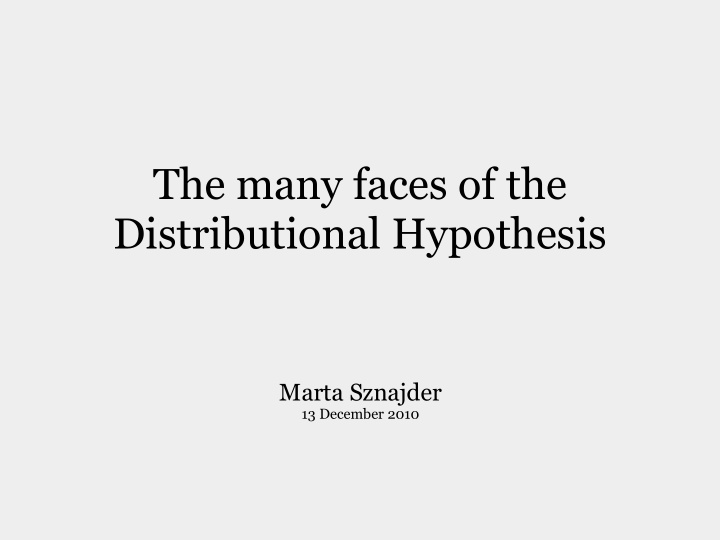



The many faces of the Distributional Hypothesis Marta Sznajder 13 December 2010
Overview WHY? WHAT? HOW?
WHY? In the class we discussed in some detail Lenci's paper on distributional semantics. The approach is new and very exciting to me. I want to get to know it better, and to understand the assumptions that are made on the way there. I want to investigate different ways the Distributional Hypothesis can be formulated.
WHAT? 1. Sahlgren My point of departure will be Sahlgren's article The distributional hypothesis (2008) His point is to show that: 1. distributional semantics is semantics after all; 2. and it captures the full notion of meaning So far, so good! BUT he claims that those claims can only be true if the theory of language you work with is structuralism.
WHAT? 1. Sahlgren Distributional approaches to meaning acquisition are rooted, and thrive, in structuralist soil. Meaning in structuralism: valeur Syntagmatic and paradigmatic relations - lead to syntagmatic and paradigmatic DSM's. Distributional models are models of word meaning. Not the meanings that are in our heads, and not the meanings that are out there in the world, but the meanings that are in the text.
WHAT? 2. Distributional approaches to meaning acquisition are rooted, and thrive, in structuralist soil. GOAL: Disprove! (covert goal: understand linguistics a bit more) Show that the notion of meaning presupposed by different versions of DH does not have to coincide with the structuralist one. SUBGOALS: 1. What are other versions of DH? Are they formulated explicitly? 2. What notion of meaning are they after? 3. Which broader linguistic theories are engaged here?
HOW? 1. My first ally: McDonald, Ramscar (2001) High-dimensional 'semantic space' models are also useful tools for investigating how the brain represents the meaning of words. They test the influence that changes of context have on similarity judgments. Subgoals here: 1. Explicate the version of DH presupposed here (it's not clear at all in the text) 2. Are they concerned with meaning at all? If so, what is it?
HOW? 2. The Contextual Hypothesis of Miller and Charles (1991) - a specific assumption about the cognitive format and origin of semantic representations. This goes strongly against Harris (and therefore Sahlgren?), who was anti-psychologist. Encounters of a word in various contexts shape the contextual representation - which is a cognitive structure! Subgoal: What notion of meaning here? If any?
CONCLUSION I will make a distinction between cognitive and structuralist DH and argue that it does not coincide with Lenci's weak-strong DH. (In fact, both Sahlgren and the cognitive articles assume the strong DH) I am still running around a bit lost? But what I want to do in my paper is to introduce some clarity and order into this domain - to understand better what is going on.
Recommend
More recommend